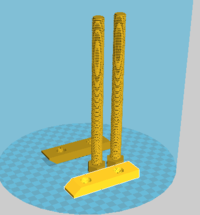| Line 9: | Line 9: | ||
==Abstract== | ==Abstract== | ||
# | # This zero-electricity fridge addresses the issue of people in third world countries not having electricity. They go to markets and buy food and then the food goes bad 2-3 days later. Having to make multiple trips to a market per week means that they both have to spend the money to get there and buy food along with lose the money they could be making working during that time. With this device, they will have a means to keep food cold for a pretty low price because the only material needed would be plastic, water, and dirt or gravel which they could just find around. The water doesn't even need to be clean, it just needs to be able to evaporate. A company is working on this project currently except not 3D printing its components and it is called Evaptainer and their units retail between $25-$35 USD. At a budget of about $50 a week even that would be considered a decently steep investment. | ||
[https://www.americaninno.com/boston/these-masschallenge-alumni-are-producing-a-portable-fridge-that-runs-on-sun-and-water/ Evaptainer pricing] | |||
# Picture of completed print using your printer [[Image:Wood_WorkingClamp_Parts.png|200px|right]] | # Picture of completed print using your printer [[Image:Wood_WorkingClamp_Parts.png|200px|right]] | ||
Revision as of 02:32, 18 November 2019
Title of the device or system
Project developed by Ian Beauoin [1]
Template:Statusboxtop Template:Status-design Template:Status-prototype You can help Appropedia by contributing to the next step in this OSAT's status. Template:Boxbottom
Abstract
- This zero-electricity fridge addresses the issue of people in third world countries not having electricity. They go to markets and buy food and then the food goes bad 2-3 days later. Having to make multiple trips to a market per week means that they both have to spend the money to get there and buy food along with lose the money they could be making working during that time. With this device, they will have a means to keep food cold for a pretty low price because the only material needed would be plastic, water, and dirt or gravel which they could just find around. The water doesn't even need to be clean, it just needs to be able to evaporate. A company is working on this project currently except not 3D printing its components and it is called Evaptainer and their units retail between $25-$35 USD. At a budget of about $50 a week even that would be considered a decently steep investment.
Bill of Materials
- Provide a full BOM -- Materials needed for fabrication of device and alternative materials if they are not available, prices/sources of non-printable parts
- Upload and link to all source files from open source CAD
- Upload and link to all STLs
Tools needed for fabrication of the OSAT
- MOST Delta RepRap or similar RepRap 3-D printer
Skills and Knowledge Necessary to Make the OSAT
- If you used special skill – link to relevant Wikipedia or Wikiversity articles/courses
Technical Specifications and Assembly Instructions
- Provide directions for print/assembly - be detailed enough in your “how to” to ensure that someone could construct the device from your description. Consider the elegance of IKEA like instructions.
- Include print time estimate
- Include assembly time estimate
- Including drawings or pictures of the device at stage of assembly at minimum. (http://www.appropedia.org/Special:Upload)
- Consider video if appropriate
| Example video summary of textbook |
|---|
Error in widget YouTube: Unable to load template 'wiki:YouTube' |
Common Problems and Solutions
- Include common mistakes/problems to avoid in building your OSAT and how to overcome them
Cost savings
- If your solution is not a low cost one then it is not really appropriate.
- Estimate your costs
- Find a commercial equivalent, cite it and put the [url in square brackets]
- Calculate $ savings and % savings
Benefited Internet Communities
- Name and add links to at least 5 using single brackets around [url name]
References
- The sources of information (e.g. engineering handbooks, journal articles, government documents, webpages, books, magazine articles etc.). References should use the <ref> </ref> and <references/> tags and can be in any format but should include all the information necessary for someone else to find the same information you did. For example: [1]
- ↑ web page: Department of Energy (DOE) Landscaping and Energy Efficiency, DOE/GO-10095 (1995) Available: http://www.eren.doe.gov/erec/factsheets/landscape.html
Based on the developmental needs addressed (e.g. food, heat, electricity, clean water, health care, etc.) be sure to label your device in the proper categories e.g. use [[Category:Water]]. Be sure to categorize your device so that it will be easy to find – for example “Low voltage connection basics” is categorized in [[Category:How tos]] [[Category:Electricity]] [[Category:Electric lighting]].
